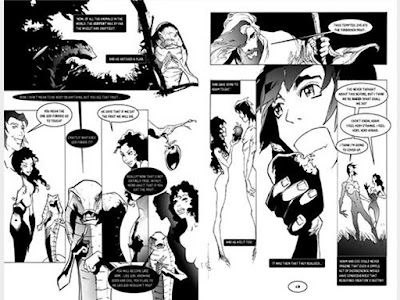Visual story telling has long been used in religious education of illiterate or semi-literate population. V&A Cast Court Collection has Hildesheim doors (1015) on display. They are decorated with images from the Creation of Eve to Christ appearing to St Mary Magdalen. Churches frequently have stained glass windows and statues showing sequences of Biblical scenes, to aid the less educated with their knowledge of the Testaments. Visual narrative allows engagement of a more diverse "reader", as a result, wider communication and bigger impact on the religious thought.
Here is 12th century manuscript Bible of Stephen Harding . Folio 13 features the story in a format of a comic. I have not managed to find out much about the manuscript, except, that it is held at Bibliothèque municipale de Dijon and some scanned folios can be found HERE.
Manga Bible is a spectacular publication of the best manga drawing. A five-volume manga series is based on the Christian Bible and created under the direction of the non-profit organization Next, formed by people from the manga industry. Though first published in English, the books are originally written in Japanese and each volume is illustrated by a Japanese manga artist. Each book is adapted from the Bible by Hidenori Kumai.
And then there is Robert Crumb's Genesis ( Nominated for three 2010 Will Eisner Comic Industry Awards) and Nestor Redondo + Joe Kubert's DC Comics Stories from the Bible : both are fabulously edgy, risque and fresh; in contrast to many others, which are roughly interchangeable with a range of books seen in Christian bookshops' windows. This is what Crumb said to Paris Book Review:
In all the comic-book versions I was able to find, they just made up dialogue, pages of it that are not in the Bible. I was reading this one thing and I thought- did I miss this? And I went back and checked against the text and it’s not in there. And they claim to be honoring the word of God, and that the Bible is a sacred text… the most significant thing is actually illustrating everything that’s in there. That’s the most significant contribution I made. It brings everything out.Could his comic version of the Bible be the most honest one yet?
Nestor Redondo and Joe Kubert's DC Comics Stories from the Bible was printed in 1975 and covers the stories from Creation to Sodom & Gomorrah.


















No comments:
Post a Comment